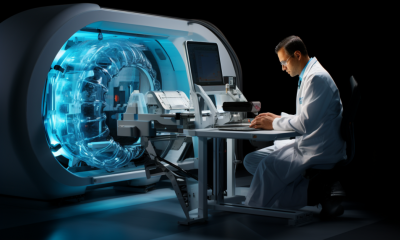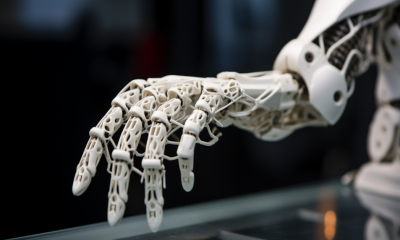BioTech
New Technique Allows 3D Printing of Functional Brain Tissue

Securities.io maintains rigorous editorial standards and may receive compensation from reviewed links. We are not a registered investment adviser and this is not investment advice. Please view our affiliate disclosure.
Table Of Contents

3D Printing Organs
3D printing, or additive manufacturing, is quietly revolutionizing the way manufacturing is done, with hundreds of materials now available for 3D printing. However, maybe the most exciting material is not for manufacturing but for medical purposes: biological tissues.
Bioprinting might one day make it possible to literally 3D print a human heart, liver, or lung on demand, ready for transplantation. It is something we explored in our article “Organs On Demand: Best 3D Bioprinting Stocks”.
A new level in bioprinting has been achieved by a research team at the University of Wisconsin–Madison, led by Su-Chun Zhang, professor of neuroscience and neurology. They managed to 3D print brain tissues that can grow and function like typical brain tissue. This is truly revolutionary and a much better result than all previous attempts to 3d print brain tissues until now.
Optimized Bio-Ink
The key to this scientific breakthrough was to adapt the usual technique for bioprinting to the specific needs of neurons.
Usually, bioprinting adds cells onto each other vertically, using some complex scaffolding material. Instead, Zhang's team went for a horizontal design, and used much softer bio-ink gel than previously used.
The softer gel allows the neurons to grow and interact with each other exactly how they do in a real brain. The relatively thinner gel also allowed for better oxygen penetration, and the thinner-grown tissue could fully absorb nutrients from the gel.

Source: Cell Stem Cell
Altogether, this creates a tissue that is much more like real brain tissue than any existing model. Not only are the tissues more connected, but it is possible for neurons to communicate normally with each other, as well as add supporting cells to the tissues. These support cells are not neurons involved in the neuronal/nerve activity but play a key role in keeping the active neurons functional and healthy.
A New Research Tool
Compared to what is currently used, cerebral organoids, these 3D printed brain tissues are much more realistic and helpful to understanding how a real brain works.

Source: Broad Institute
By totally controlling the structure of the model brain tissue, researchers can use this technique to create realistic replicas of brains suffering from Alzheimer's disease, Down syndrome, etc.
“Because we can print the tissue by design, we can have a defined system to look at how our human brain network operates. We can look very specifically at how the nerve cells talk to each other under certain conditions because we can print exactly what we want.”
As the brain operates in a network, the high level of interconnectivity will be crucial for helping fundamental research progress.
The cherry on the cake is that this new printing technique does not require any new equipment. It can be done with a benchtop commercialized 3D printer, and the analysis of the neurons can be done with common methodologies like microscope imaging and electrodes, which are already common in neurology labs.
Bioprinting Stocks
1. BICO Group AB
Pr Zhang's team used a Cellink printer to perform their bioprinting of brain tissues.
In 2021, Cellink was renamed as the BICO Group, following its acquisition of Cytena in 2019 and Scienion in 2020. Cellink is still the brand name for the bioprinting part of the business.
Bioprinting represented in Q3 2023 $16M in sales, in addition to the $28M in biosciences and the $12M in bioautomation.

Source: BICO Group AB
While not alone in the field, Cellink is clearly a very advanced bioprinting equipment manufacturer. The achievement of Pr Zhang using these machines shows their potential in neurology research, a field for now not really using bioprinting.
In the long run, bioprinting companies are likely to evolve from providing tools to researchers to becoming suppliers of pharmaceutical companies' bioprinting therapies for patients. This will, in turn, completely change the number of bioprinters in use and, more importantly, the volume of consumables sold every month.
This is the same process that occurred for other biolab equipment manufacturers, including genome sequencing machines from PacBio (PACB) and Illumina (ILMN), which end up making 80% of their revenues from recurring sales of consumables.
2. Organovo
Organovo Holdings, Inc. (ONVO +0%)
Organovo's proprietary technology uses 3D-printed human tissues to mimic key aspects of real human tissues, including composition, architecture, function, and disease.
This was used to find new molecules with therapeutic potential. By first validating the potential molecules in the 3D tissue model, the company hopes to reduce the risk of failures in the clinical trial, thanks to a more realistic in-vitro cellular model before any testing is done on humans.
Organovo's pipeline is focused on Inflammatory Bowel Disease (IFD) and liver fibrosis, with one program in phase 2/3 of the clinical trial and one in phase 1. The Phase 2a POC results are expected in 2H 2025.

Source: Organovo
There were 2.1 million cases in the US in 2022 and 13 million cases globally of ulcerative colitis, a form of IFD, representing a $6.6B market. It is also expected to keep growing at 6% CAGR until 2032, to a $12B market.
As Organovo uses a realistic simulation of the intestinal tissue, with polarized epithelium and interstitial layer, it is likely that they have a good representation in-vitro on how their drug will act for a patient.

Source: Organovo
This makes Organovo an interesting stock for investors looking to capitalize on the early days of bioprinting and its use as a model for biotech companies to uncover new therapies.
Jonathan is a former biochemist researcher who worked in genetic analysis and clinical trials. He is now a stock analyst and finance writer with a focus on innovation, market cycles and geopolitics in his publication 'The Eurasian Century".
You may like


Investing in 3D Printing Stocks (Additive Manufacturing)


Top 10 Additive Manufacturing And 3D Printing Stock to Watch (July 2025)


Additive Manufacturing May be Key in Commercializing ‘Liquid Metal Ram’


Acoustic Monitoring – Is It The Key to Commercializing Laser-Based Additive Manufacturing?


Can Additive Manufacturing Improve Healthcare Diagnostic Technology?


Hands Like a Human: New Additive Manufacturing Helps Soft Robotics Go Real